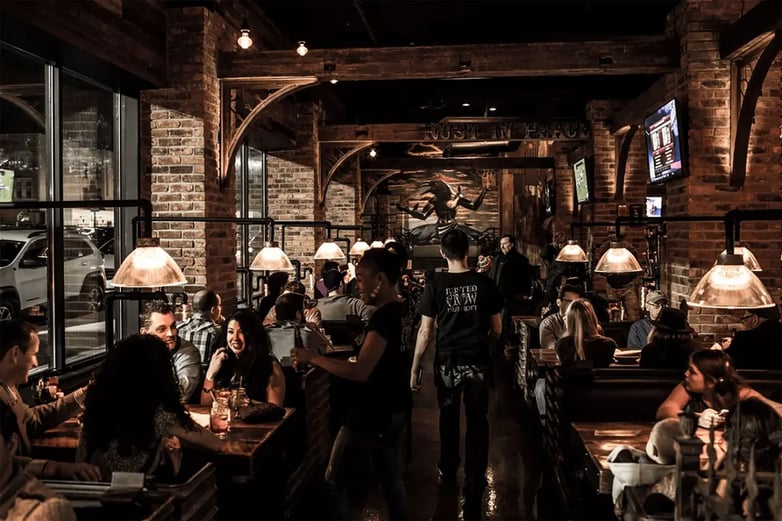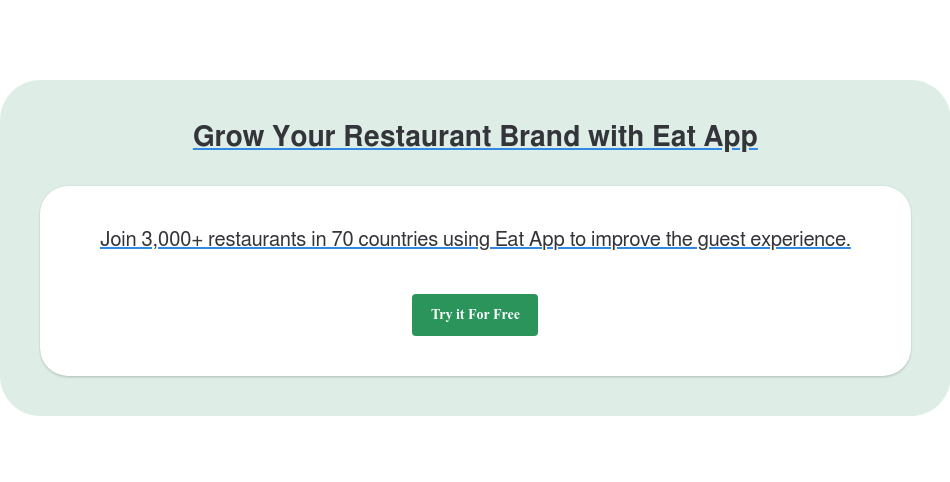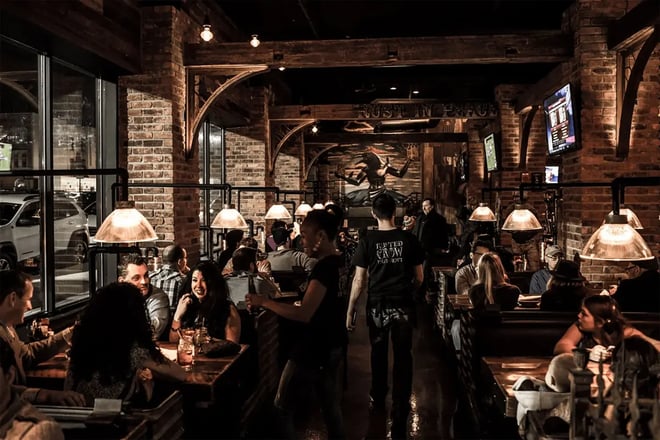The tables at your restaurant are like real estate. The more time they’re occupied, the higher your revenue. As a restauranteur, you want to make sure that all of your tables are being used to their maximum potential. This is why table turnover is such an important metric for restaurant success.
It’s a tricky one, though. Is it better for your servers to rush out diners as soon as possible to empty the table for the next party, or to take their time and provide diners with a good experience?
That’s where finding the right balance comes in. It’s important to find the perfect blend between turning tables and providing a good guest experience. By doing so, you will ensure that your staff is able to serve as many customers as possible without negatively affecting customer satisfaction. It’s a win-win situation.
Finding that sweet spot, however, is not simple by any means, and comes down to the efficiency and effectiveness of your overall restaurant operations - starting from the kitchen processes, right to the very last job of dropping the cheque. Any inefficiencies in operations will create a bottleneck which will eventually lead to slower table turnover rates.
In this article, we will go through a few tried and tested methods that can be used to improve your restaurant’s table turnover rate by maximizing overall restaurant efficiency, without affecting guest satisfaction.
But before we go any further, let’s get a deeper understanding of table turnover at a restaurant.
Key Takeaways
-
Table turnover rate is a crucial factor in maximizing restaurant revenue.
-
Factors that affect table turnover rate include menu complexity, staff efficiency, reservation management, and guest behavior.
-
Streamlining menu options, improving staff training, and implementing a reservation system can help improve table turnover rates.
-
Minimizing wait times and optimizing table seating can also help improve the table turnover rate.
-
Analyzing data and regularly reviewing processes can help identify areas for improvement and optimize the table turnover rate.
-
Improving the table turnover rate can lead to increased revenue and a better guest experience.

What is the table turnover rate and how is it calculated?
Table Turnover Rate measures the amount of time your tables are occupied during a given period of time. Before you start trying to improve your table turnover rate, it’s important to understand how it’s calculated.
For calculating the table turnover rate, first pick a time period you want to measure, for example, the lunch shift, a day, a week, or even a month. Then, find the number of parties served at each table during the chosen time period. The final calculation is done by dividing the number of parties served by the number of tables.
No. of customers served in a given time period/No. of tables = Table Turnover Rate
Calculating your restaurant’s turnover rate will help you better understand the current situation and compare it with industry benchmarks to identify what strategies need to be put in place. There is no “one size fits all” approach when it comes to table turnover rate, it differs from restaurant-to-restaurant based on factors like style of restaurant (fine-dining/casual), target market, and many other factors. The average turnover rate for a family restaurant, for example, is 3.
The aim of optimizing your restaurant’s table turnover rate is to maximize your restaurant’s capacity. The quicker the tables turn, the more people you can serve, the more revenue you earn. Your restaurant’s profitability is directly related to its turnover rate, and therefore, it should not be taken lightly.
Another important metric to keep in mind is the seat turnover rate, which calculates the number of times each seat at your restaurant is occupied during a given period.
No. of customers served in a given time period/No. of seats = Seat Turnover Rate
If your seat turnover rate is lower than your table turnover rate, it indicates that you’re not filling all the available seats. This may happen if your restaurant mostly houses bigger tables of 4-6 but is visited by smaller parties. So even when the table is occupied, some of the seats are still empty. This number will help you get a better understanding of your restaurant's capacity and ways of optimizing it better.
10 Tips for improving table turnover rate
1. Train your servers
Well-trained front-of-house staff can take your restaurant’s service from good to excellent while also improving efficiency. It’s simple - the better they are at their job, the more streamlined the entire process, from the first greeting to the check drop. Training them well will make it easier to find that sweet spot between improving the turnover rate and maintaining customer satisfaction.
Download our free server training manual here.
2. Streamline your kitchen operations
While your servers are the ones dealing with the customer, your back-of-the-house plays an equally important role in improving efficiency. Make sure that all the kitchen roles and processes are clearly defined so that the food is prepared as quickly as possible. Lousy, unclear processes will lead to delays and bottlenecks in the kitchen, which will lead to slower service, and eventually slower table turnover rate
Download our free restaurant operations manual here
3. Keep your menu simple
If your menu is filled with complicated dishes that would have people calling out to the servers for an explanation, or has so many options that people end up taking a long time to decide their order, it is going to affect your turnover rate. Keep your menu sweet and simple, try to add descriptions and pictures where possible to reduce the need for further explanation. This will save both the guest’s and the server’s time.
4. Don't seat incomplete parties
Putting a policy in place to not seat incomplete diners can really help improve your table turnover rate. Instead of people waiting at the table for their friends to join and occupying it for a long time, request them to be seated in the waiting area so that the table is free for another party while they wait. This policy can be used flexibly - more rigid during peak times and relaxed during non-peak hours
5. Serve guests as soon as possible
Establish a “one-minute rule” at your restaurant where servers have to ensure that each guest is approached within one minute of being seated at their table. This will not only improve customer experience but also reduce their service time. If you have people waiting around to be served at tables, both your guest experience and the turnover rate is suffering.
6. Play around with design and ambiance
Modifying a few elements of your restaurant’s atmosphere can encourage diners to leave early, like loud music, not-so-comfortable chairs, even bright colors, and lighting. Guests are more likely to stay longer and camp out in a cozy, comfortable environment.
7. Assign more servers to larger parties
Parties with 6+ diners can take time to serve. Assigning multiple servers instead of one can help quicken the process. You don’t want one server taking 100 trips back and forth from the kitchen to serve just one table. 2-3 servers together can serve big parties more productively and efficiently.
8. Optimize overall operations
For improving your table turnover rate, it’s important to understand what are the pain points in your overall operations that need to be addressed. The key to a good turnover rate is a restaurant that runs like a well-oiled machine. Deep dive into your restaurant performance insights to gain a better understanding of current operations. Are there too many no-shows and cancellations? Are the wait times too long? Are the servers being distributed properly? Reviewing these data points can help identify any issues and bottlenecks and help you devise solutions for the same.
Read More: How restaurants are using data to increase revenue
9. Add a virtual waitlist
Adding a virtual waitlist to your reservation process i.e. an online waitlist where people can list themselves without having to visit the restaurant is another great way of improving your table turnover rate. By implementing this, guests would no longer have to wait in line for tables to get empty and can easily get notified as soon as a table is available. It also helps your tables get occupied as soon as one party leaves and negates the risk of losing potential customers when all the tables are occupied.
Learn more about Eat App’s Virtual Waitlist
10. Use technology
Employing technology like a table management system can play a major role in improving your restaurant’s table turnover rate with advanced features that help improve operational efficiency and create a more streamlined flow of operations.
Here are some ways table management systems help improve your restaurant’s table turnover rate:
- Floor plan customization: By allowing you to customize and update your floor plan in real-time, systems like Eat App help your staff better understand the floor’s current situation with a quick glimpse.
- Online reservations: Easy and streamlined online booking processes make it simpler for guests to make bookings, allowing restaurants to be better prepared for upcoming shifts.
- Efficiency in service: Table management systems enable your staff to be armed with guest information including their preferences, past visits, etc. before the guests even walk in through the doors. This makes it easier for them to provide an efficient and effective service to the diners.
- Advanced reporting: Most table management systems, like Eat App, also come equipped with in-depth reporting capabilities that help owners better understand their restaurant’s performance and make actionable decisions to improve table turnover rates.
- Overall operational efficiency: With one centralized system in place for the overall restaurant management, table management systems enable a cohesive management experience eventually leading to streamlined operations and improved table turnover rates.
Interested in finding out more? Schedule a free demo with one of our product specialists today!














.webp?width=200&name=v2-15mknc-qpw1b%20(1).webp)
.webp?width=200&name=v2-15kqni-p0exl%20(1).webp)
-1.png?width=1812&height=1072&name=TripAdvisor%20%26%20More%20Bookings%20(1)-1.png)
-2.png?width=1812&height=1072&name=Google%20Bookings%20(1)-2.png)


-1.png?width=200&name=TripAdvisor%20%26%20More%20Bookings%20(1)-1.png)
-2.png?width=200&name=Google%20Bookings%20(1)-2.png)
-1.png?width=200&name=Instagram%20Bookings%20(1)-1.png)
-1-png.webp?width=200&name=Facebook%20Integration%20Rectangle%20(1)-1-png.webp)







.webp?width=200&name=download%20(1).webp)
%20(1)-2.webp?width=200&name=Eat%20(34)%20(1)-2.webp)
%20(1)-2.webp?width=200&name=Eat%20(18)%20(1)-2.webp)








.webp?width=314&height=175&name=Chit%20Printer%20Banner%20(8).webp)



.webp?width=144&height=72&name=Eat%20App%20Logo%20(3).webp)